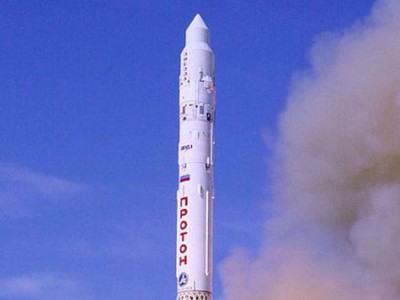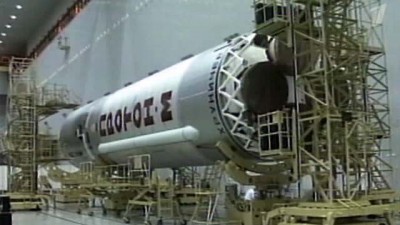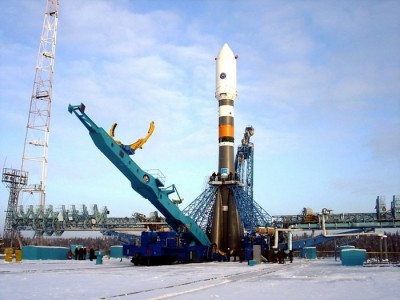This banality fault, according to the words of sources of information, caused immediately after the start of the cranking system of stabilization of the carrier rocket "Proton-M" incorrect data from the sensors, as a result of which the rocket lost the instrument orientation. Because erroneous data from the sensors complied with the stabilization system missiles, the situation is constantly horšila. This version, inter alia, confirmed by the video footage of the rocket launch, where it is very clearly see the swinging of the rocket from side to side immediately after its launch.
"According to logic", it is considered a source of information, "an incorrect connection of the sensors should be found in a comprehensive review of the missile and directly in the manufacturing plant and then at the next review in Baikonur.". However, according to information from the other sources of information from the space sector "... the necessary checks and controls before the start of the rockets have been performed.I have information about the fact that the state commission, which is traditionally held the day before the start, either not occurred or been carried out strictly formally.".
Today, many like to repeat that Russia in the space field haunted by failures: once it's the fault of a rocket motor of the carrier, other times the error of the last stage, that of the satellite placed on the orbit. The result is that the satellite, which is worth billions, are not located on the calculated orbit and become space trash. And it is increasingly more frequent for these trouble standing members of the "human factor".
Particularly the negative impact of these errors is on the completion of the navigation satellite system "Glonass". In December 2010 fell into the Pacific ocean at the same time three of the satellite (as now) "Glonass-M". At the time, the commission found that the last stage, which put a satellite into orbit, wrongly filled 1.5 tons of unnecessary fuel. The carrier before disconnecting the last stage with the satellites did not reach the necessary height. And the year before (2009) in preparation for launch of the same carrier "Proton-M" fell into the empty tank oxidizer any mother or pliers and a start had to be delayed for a few days.
This time, even at a time when the commission of inquiry describing the possible causes of the accident "Proton-M", run the version that the sensors of the angular velocity switched plus and minus, on many discussion forums in the Internet and this version was by many experts considered to be the most likely. However, the most important question, which was concerned with totally tots, was: How is it possible that Russia, more recently, the leading space power, could occur in such a neprofesionalismu?
In connection with this, it is appropriate to quote one of the professionals, which is about the problems of the rockets expressed on the forum of the magazine "Novosti kosmonavtiki":
"Regarding the possibility or impossibility of such defects in this area take the liberty to remind some of the problems of the past. One of the Glonassů-M to this day flies with přehpzenými the sensor of angular speed. Simply there was a time to look and understand that it is not controlled in the initial stage and the off mode to all the work doesn't go to waste. Further got lucky to match the energy source with the position of the Sun and thereby ensuring the employability of the apparatus. According to the story on Molnii-3K happened that one of the solar sensors was when the assembly is rotated about 120°. Military representative of the NPO Prikladnoj mechaniky on the polygon to see that it's not right, but he was too shy to ask, or warn, because I was afraid that it will be considered a fool. But it is nothing like a "one lady said," because I was personally present. Still a bit of an older story has become an old satellite "Molnija", when in the course of training and examination issued a command to open the solar panels. Nearly killed one soldier. To avoid any additional similar cases, the commander ordered to wrap the capsule with a rope for further testing. Well and because the string been taken down (a little forgot about him), so the satellite flew with him. The result was that wasn't opened up even one solar panel. There is no electricity, not management. Still up there somewhere flying malfunctioning satellites wrapped with string ... Or happened in the race Raduga that when a soldier had sestykovat connectors so it got confused and switched the two between each other. Because the connectors but should be the key (just to avoid swapping), so didn't get laid. Our brave soldier such but you mind and make it look like a made, so it is just enclosed and wrapped with electrical tape, as it's right. aštěstí it came in předstartovních clearances, because not a single command through. The satellite was suddenly lost. Just connect your device, to confuse the designation, etc. can be really simple.".
List of accidents in the area of the Russian astronautics in recent years:
The fall of the carrier "Proton-M" with three satellites "Glonass-M" is the third incident in the Russian aerospace in 2013.
This was before two of two accidents carrier rockets "Zenit" from the program "Sea launch" and incorrect lifting into orbit of military satellites:
- 15. January 2013 was launched the rocket - carrier "Rokot" with the orbital vyváděcím stage "Briz-KM" and the satellites of the Ministry of defence of the RUSSIAN federation. Start concluded supply satellites on orbit, the near calculated. As inform the Russian mass media, with only two of the three satellites managed to establish a connection. The commission Roskosmosu should investigate the causes of the may, but there's still works and the results submitted. To the resumption of launches of carriers "Rokot" should occur in September of this year.
- 1.February 2013 at the launch of the rocket "Zenit-3SL" with the satellite Intelsat-27 under the program "Sea Launch" the crash occurred and the rocket fell into the Pacific ocean 2.5 km from the launch platform. The cause of the interruption of the flight was the malfunction of on-board power source, which provides thrust vector control engines in the first degree.
- 5. December 2010 through the fault of the failed launch fell into the Pacific ocean 3 satellites "Glonass-M". Created by skoda in the amount of 2.5 billion rubles. A special commission found that the accident occurred due to an error in the design documentation orbital vyváděcího instance, which was filled with unnecessary fuel weight of 1.5 t.
- In February 2011, when the supply of a military geodesic satellite "Geo-IK-2" on the orbit of the carrier rocket "Rokot worked correctly, but in the course of the work of orbital vyváděcího instance of the "Briz-KM" developed and produced by Cosmic center Chruničeva occurred extraordinary situation, whose result was the stripping of the satellite "Geo-IK-2" on a different orbit than was calculated. In June, it was unofficially reported that the satellite was finally lost.
- 18. August 2011 the carrier rocket "Proton-M" with the orbital vyváděcím stage "Briz-M" and satellite "Express-AM4" was launched from the baikonur Cosmodrome. In the course of the work of orbital vyváděcího degrees between the fourth and fifth lighting air the engine has been broken broadcast telemetry information to Earth. In the expected arrival time has established a connection.
- 24. August 2011 was launched a carrier rocket "Soyuz-U" with the space cargo ship "Progress M-12M" was launched from the baikonur Cosmodrome. Due to the crash of the engines of the third degree was not a space cargo ship escorted to the orbit, and its debris fell in the Altai.
- 9. November 2011 from Baikonur launched interplanetary station "Fobos-Grunt". After separation from the carrier rocket "Zenit" on the support platform of the station off-line engines, which should be on the departure trajectory to Mars.
- In December 2011 fell immediately after launch from the cosmodrome Plesetsk the coupling of the satellite "Meridian". Telecommunications satellite of the new generation of "Meridian" are placed on the high eleptickou orbit by the carrier rocket "Soyuz-2" and orbital vyváděcího the degree of "Frigates". The cause of the crash of the carrier rocket "Soyuz-2.1 b" with a military satellite "Meridian" was a failure of the engine.
- 6. August 2012, the carrier rocket "Proton-M" with the orbital vyváděcím stage "Briz-M" and two connecting satellites - the Russian "Express-MD2" and indonesian "Telkom-3" starovala from the baikonur Cosmodrome. Carrier rocket worked correctly. The location of the satellites in the orbit should be done four thrusts of air to the engine angular vyváděcího degree. The third burst would be shorter than was required, and the fourth had not run. Satellites were not placed in the required orbit and were lost.
- To a special situation occurred during the deletion of a large geostationary satellite "Yamal-402". It was launched with the help of the carrier rocket "Proton-M" 8. December 2012 with orbital vyváděcím stage "Briz-M", which had a satellite put into orbit. However, as a result, the flight engine of this degree worked during the fourth ignition timing about 4 minutes less time, was a satellite "Yamal-402" placed on the wrong orbit. Satellite but was placed on the correct orbit using its own engine. Maneuver follow, the specialists of Thales Alenia Space and the necessary orbit was achieved by using the four maneuvers: the first 9. - 10. December 2012, the second 10. - 11. December 2012 and the third 12. December 2012. Last, the fourth, the maneuver was carried out 15. December and the satellite reached the desired geostationary orbits.
Source of information: http://nnm.me/blogs/samovar1/plyus-na-minus/.


